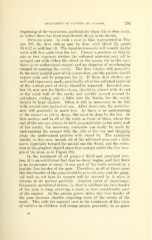Page 449 - My FlipBook
P. 449
EXCAVATION OF CAVITIES BY CLASSES. 201
beginning of the excavation, particularly when this is done early,
or before there has been considerable decay in the dentin.
Outline fobm. In such a case as that represented in Fig-
ure 283, the first cutting may be done with chisel 15, spoon
15-8-12 or with bur 10. The hand instruments will usually do the
work with less pain than the bur. Choose a position so that by
one or two vigorous strokes the softened material may all be
scraped out with either the chisel or the spoon, for in this case
there is no undermined enamel and no chipping of overhanging
enamel in opening the cavity. The first strokes will generally
be the most painful part of the excavation, and the patient should
expect pain and be prepared for it. If these first strokes are
well and vigorously made, practically all of the softened material
of the central part of decay should be removed. Inverted cone
bur 10, new and the blades sharp, should be placed with its end
to the axial wall of the cavity and quickly passed around its
periphery, cutting only a little into the dentin, for the cavity
should be kept shallow. Often it will be necessary to do this
with several cuts instead of one. After these cuts, the sensitive-
ness will generally be much less. As there is no undermining
of the enamel as yet by decay, this must be done by the bur. In
first molars, and in all of the teeth in front of them, where the
end of the bur can always be held perpendicular to the axial wall
of the cavity, the necessary extension can easily be made by
undermining the enamel with the side of the bur and chipping
away the undermined portion with chisel 15. The extension
should, in this case, include all of the whitened area and a little
more, especially toward the mesial and the distal, and the exten-
sion to the gingival should place that margin under the free mar-
gin of the gum, as in Figure 284.
In the treatment of all gingival third and proximal cavi-
ties, it is an established fact that no decay begins, and that there
is no recurrence of decay in any part of the tooth covered by a
healthy free border of the gum. Therefore, in all of these cases
this free border of the gum should be pressed away and the gingi-
val wall so cut that its margin will be covered by it when it
returns to its normal position. Another i^oint of importance,
frequently mentioned before, is, that in children the free border
of the gum is long, covering a more or less considerable part
of the enamel. As the person grows older, this free border of
the gum becomes shorter, exposing more of the crown of the
tooth. This calls for especial care in the treatment of this class
of cavities in children and young people generally, to so place
3»


